According to eMarketer data, Amazon accounted for 41.4% of all U.S. e-commerce sales in 2021. For many brands, not selling on Amazon means missing out on customers who prefer the shopping platform. Below are tips on how your brand can optimize their Amazon presence.
Tap into affiliate partnerships.
To tap into affiliate partnerships, host a branded affiliate sign-up page to incentivize creators to showcase your products. Reaching out to creators makes it easier to find your affiliate link and, in turn, helps boost exposure and sales.
Save on advertising dollars by offering discounts.
According to a February report by Marketplace Pulse, Amazon takes more than 50% of seller’s revenue. Transaction fees, fulfillment fees, and advertising costs eat into the seller's bottom line. Organic search is nonexistent, as the best screen real estate is saved for advertised products. Relying on organic placements could lead to 0 sales! Brands are finding that the best way to balance cost efficiency and exposure is to lean in on discounts.
Share your brand story.
Your Amazon Storefront page is not just a place to push your products, but a place to educate consumers about your brand and what products you have to offer. A strong brand story should shine throughout your storefront. This story should include why you started your brand, what you have to offer, and what differentiates your products from the rest of the competition. Creating an “about us” page is an effective way to strengthen your brand story and share with consumers why your brand and products are special. When consumers have a reason to love your brand, they will want to engage with you, which can lead to conversions.
Utilize high-quality images.
High quality content and images could not be more crucial to the success of your Amazon storefront. The goal is to create a similar shopping experience for your customer as they would have in a physical storefront. This is where high-resolution images come into play! With millions of products for sale on Amazon, first impressions are everything. Low quality images can turn away potential customers to your products. The more enticing your photos within your listings, the more customers will gravitate towards your products. Utilizing top quality images on your storefront will improve your product’s performance and create a strong brand identity.
Optimize your Product Pages and Brand Page
Amazon has its own SEO, but it is different from Google due to user intent. Users are not searching ‘how to’ on Amazon, instead the searches are product-based designed for making purchases. As a seller, understanding how A9 works can greatly impact your success. A9 considers factors like product relevance, customer preferences, sales performance and keywords to determine product rankings. To maximize visibility, sellers should conduct keyword research, optimize listings with relevant keywords and compelling descriptions, maintain competitive pricing, and leverage advertising solutions like Sponsored Products. Encourage positive reviews and promptly address any negative reviews. For backend keywords, it’s important to limit to 250 characters, avoid repeating words, avoid commas, include synonyms and variation in spelling, and don’t reuse keywords from the first 80 characters of the product title. Make sure to regularly monitor performance and make adjustments to improve visibility, conversion rates, and overall success on Amazon.
Photo: ©alexsl

